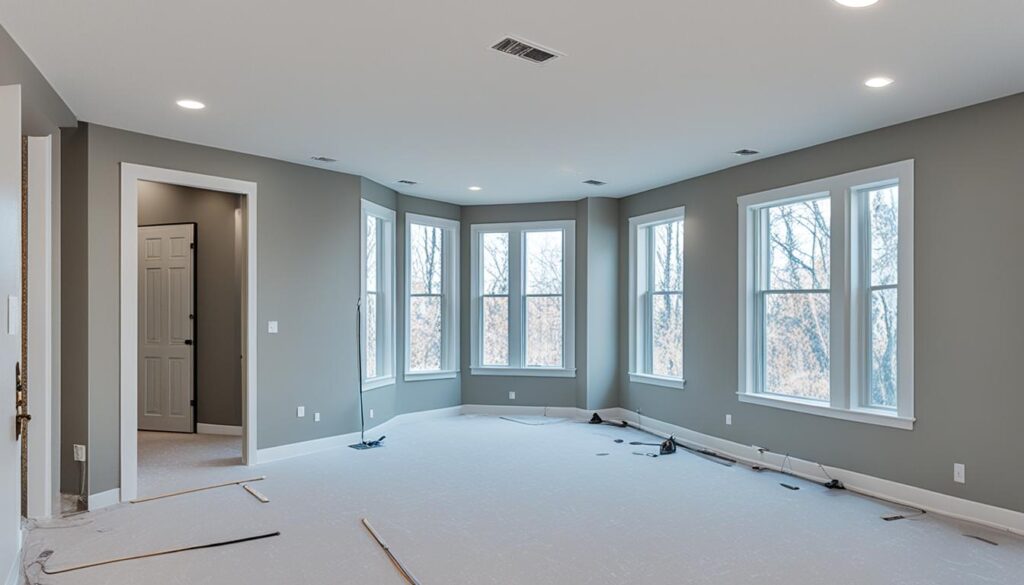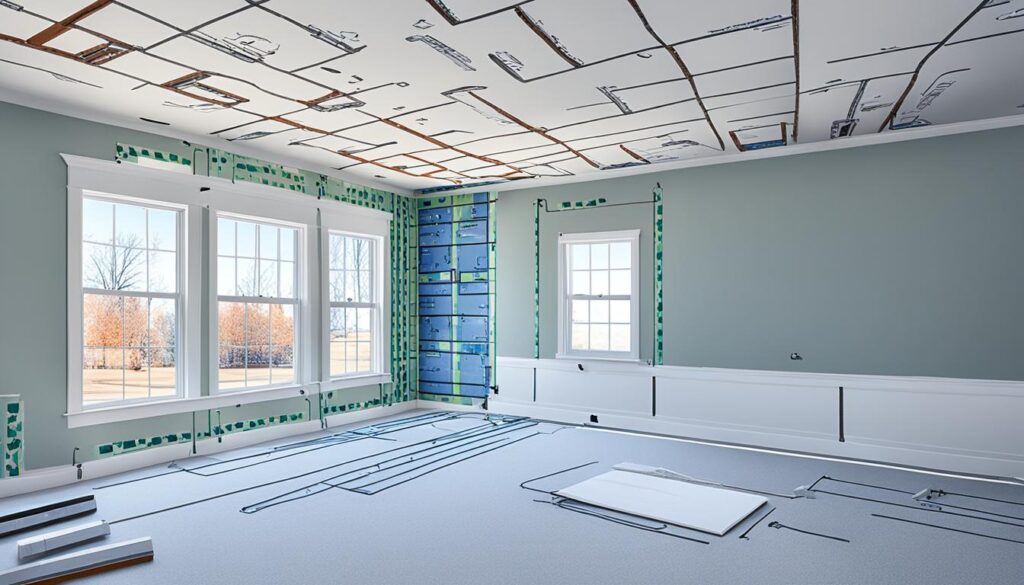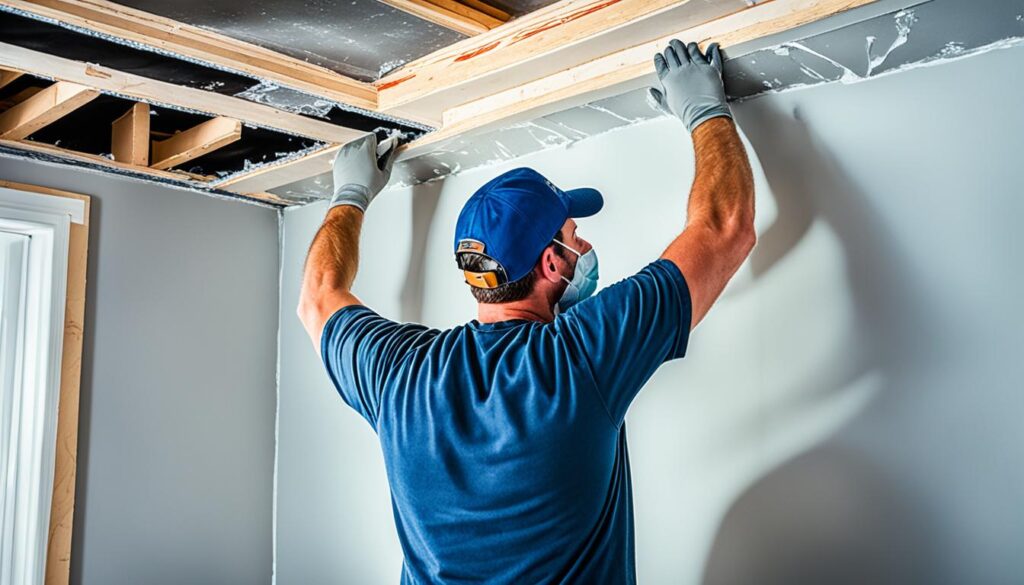
Soundproofing a room with drywall helps cut down unwanted noise effectively. You can make your spaces quieter by following simple steps and choosing the right materials. This turns your place into a more peaceful spot.
The first thing to do is install soundproof drywall. It’s made to stop sound from moving through walls. You can make it even better by putting insulation between the wall studs. Also, make sure to seal any gaps with acoustic caulk or resilient channels for more silence.
For the best results, pick drywall from brands like QuietRock or CertainTeed. They produce drywall that’s heavy and can absorb more sound. This makes your room quieter.
The price of installing soundproof drywall depends on many things. Room size, how complicated the setup is, and the material you choose all play a part. But, spending on soundproofing can make your space more enjoyable and calm.
Key Takeaways:
- Soundproofing a room with drywall is an effective technique to reduce noise transmission and improve acoustic insulation.
- Install soundproof drywall and add insulation to enhance soundproofing capabilities.
- Seal gaps and cracks with acoustic caulk or resilient channels to further enhance soundproofing efficiency.
- Look for reputable brands like QuietRock, CertainTeed, or National Gypsum when selecting the best drywall for soundproofing.
- The cost of drywall soundproofing can vary, but the investment can significantly improve the quality of your living spaces.
Understanding the importance of soundproofing
Soundproofing is essential for creating a comfortable and quiet environment. Living in a noisy place or dealing with loud neighbors makes peace hard to find. But, with good soundproofing, you can block out much of that noise. It makes your home a calmer, more relaxing place.
When it comes to soundproofing, walls play a critical role. Sound travels easily through walls, bringing noise from the outside or nearby rooms into your space. Soundproofing walls stops this, adding more quiet to your home.
There are various noise reduction techniques and soundproofing materials available to help achieve effective soundproofing for walls. Installing soundproof drywall is a good start. It’s made to stop sound from moving through it. Adding insulation to walls helps too, as it absorbs sound. Acoustic panels can also be used to cut down on noise, improving the overall sound quality of your space.
Benefits of soundproofing walls
There are many pluses to soundproofing your walls:
- Minimize noise from other rooms or outside
- Create a calmer, quieter living space
- Keep things private by stopping sound from traveling through
- Help improve sleep and relaxation
Choosing the right soundproofing materials
Picking the right soundproofing materials is key. It depends on what you need and your budget. Here are some top choices:
| Material | Key Features |
|---|---|
| Drywall | Specifically designed for soundproofing, reduces noise transmission |
| Insulation | Absorbs sound waves and improves acoustic insulation |
| Acoustic panels | Improves sound absorption and reduces echoes and reflections |
Using these materials helps minimize noise. That means you get to enjoy a quieter, more peaceful home.
Soundproofing windows and doors
Windows and doors let sound in easily, disturbing the peace inside. Luckily, there are ways to keep the noise out. Your home or office can be quieter and more peaceful with the right soundproofing methods.
Solutions for Soundproofing Windows
Soundproofing windows can be done in different ways:
- Soundproof Curtains: These curtains absorb noise well, blocking sound from outside.
- Window Inserts: Adding acrylic or glass panels to your windows on the inside helps create a noise barrier.
- Double-Glazed Windows: Double-glazed windows significantly cut down on noise. The space between the two panes reduces sound.
Using these solutions makes your indoor space calmer. You won’t hear as much noise from outside.
Effective Techniques for Soundproofing Doors
Doors can also let in a lot of noise. Here are some ways to stop it:
- Solid Hardwood Doors: Solid hardwood doors are great for keeping sound out. They’re thick and have fewer gaps.
- Door Sweeps: Adding door sweeps at the bottom seals the floor gap. This keeps sound from coming in.
- Draft Stoppers: Use draft stoppers around the door to block sound through tiny openings.
- Acoustic Foam Panels: Mount these panels inside the door to absorb sound. It makes the room quieter.
These steps greatly cut down on the noise that comes through your doors. Your space will feel more private and calm.

Soundproofing your windows and doors can vastly improve your home’s comfort. It’s great for reducing outside noise or creating a quiet area. With these methods, you can make your space more tranquil.
Soundproofing floors
When talking about soundproofing, floors matter a lot. Hard floors can easily let sound travel, especially in buildings with many levels. Luckily, there are numerous ways to soundproof floors and cut down on noise.
1. Rubber Mats
Consider using rubber mats to soundproof your floors. Rubber gym flooring or mats are great because they absorb sound and vibrations. Simply place them under furniture or in areas that get a lot of foot traffic. This can reduce the noise made by footsteps and other activities.
2. Carpets and Rugs
Another good way to lessen sound through floors is with carpets or rugs. Pick carpets or rugs that are dense and thick, with the right liners. These extra layers help absorb sound. As a result, the noise won’t easily flow to lower floors or other rooms.
3. Underlayment Materials
Adding underlayment below hard floors can also help with soundproofing. Materials like cork or foam act as a barrier, taking in sound and lowering noise travel. They’re simple to put in between the floor and its surface.
These tips can make your home or office quieter and more serene. Whether you go for rubber mats, carpets, or underlayment, each choice is a strong step for better sound isolation. This means you can enjoy a peaceful space to live or work.
| Method | Pros | Cons |
|---|---|---|
| Rubber Mats | – Excellent sound and vibration absorption – Easy to install and move | – Limited coverage area – May not be suitable for all types of flooring |
| Carpets and Rugs | – Effective sound damping – Wide variety of options available | – Requires regular maintenance and cleaning – May not be suitable for allergy sufferers |
| Underlayment Materials | – Enhances overall insulation – Easy to install | – Additional cost and labor – May affect the height of the flooring |
Soundproofing walls without damaging them
There are methods to soundproof walls without harm. Adding mass and soundproofing materials reduces noise. This keeps your walls strong.
Adding a layer of drywall can help. This extra layer makes walls heavier, improving their ability to reduce sound. Using products like green glue or vinyl between layers enhances sound absorption. So, you get a quieter place.
Building a separate room is another good idea. This means the new walls and ceiling don’t directly touch the old ones. It reduces sound traveling. It’s great for places that need to be really quiet, like studios or theaters.
For better sound inside a room, try using acoustical panels with fabric. They look nice and make the room sound better by absorbing sound. Place them strategically on walls to boost soundproofing.

By using these tips, you can make your space quieter without hurting the walls. Whether you choose to add mass or build a separate room, using the right materials is key to a soundproof home. Read, learn, and enjoy this awesome article.
Simple solutions for soundproofing without damaging walls
If the noise in your room isn’t too loud, you’re in luck. There are easy ways to soundproof without harming your walls. These tips help absorb sound and cut down on outside noise. They don’t require big changes or renovations.
1. Soundproof Curtains
Soundproof curtains add an effective barrier to windows and walls. They’re crafted from thick materials that soak up or stop sound waves. By setting up these curtains, you can quickly reduce how much noise comes in or out. Plus, it’s a simple fix that won’t damage your walls.
2. Window Inserts
Window inserts are a budget-friendly option for windows. You put them inside your windows to create more protection against sound. They’re usually made from materials like acrylic or laminated glass. This makes your windows better at keeping outside noise away. They’re a great way to quiet things down without installing new windows.
3. Reinforce Your Door
Doors are often weak spots for sound. Making your door sturdier can help keep noise at bay. One trick is to fill your door’s hollow parts with sand to make it heavier. This stops sound from getting through. Alternately, adding mass-loaded vinyl on the door acts as a sound barrier. Don’t forget a door sweep or draft stopper. It closes the gap at the bottom of your door, keeping more noise out.
These easy techniques can really cut down on noise. You can choose from soundproof curtains, window inserts, or making your door stronger. Each method will make your place quieter and more serene.
| Soundproof Solution | Benefits |
|---|---|
| Soundproof Curtains | Provides sound absorption, easy installation, and no damage to walls |
| Window Inserts | Affordable alternative to window replacement, reduces outside noise |
| Reinforce Your Door | Improves door’s soundproofing capabilities, prevents noise leakage |
Combine these solutions with other soundproofing methods for the best results. Adding wall insulation and acoustic panels will further reduce noise. This way, you can enjoy a quieter and more tranquil living space.
Lowering noise levels within the room
It’s key to deal with room noise, along with soundproofing. Adding things like fabric-wrapped acoustical panels can help. They absorb sound and cut down reflections.
Adding these panels to walls and ceilings boosts soundproofing. They make the room quieter and sound better. This creates a nicer space to hear in.
Using these panels with other soundproofing methods works well. Things like sealing gaps become more effective. Together, they make a room very quiet and good for listening.
At Painting Done by Angel’s, we are passionate about helping those in the Scottsdale & Phoenix, Arizona area make their homes and businesses beautiful. We provide high-quality interior and exterior painting services with 15+ years of expertise. We take great pride in providing the finest results for customers every time! We are licensed, bonded, and insured so that your investment is secure with us; We pay close attention to delivering the finest outcomes for our customers each time!
FAQ
How can I soundproof a room with drywall?
Soundproofing a room with drywall? You can do it by installing special soundproof drywall. Also, add insulation and seal gaps tight. This makes the room better at keeping sound in and out.
Why is soundproofing important?
Soundproofing matters a lot. It makes a place comfortable and quiet. To do this, you use special methods. And you pick materials that decrease sound movement.
How can I soundproof windows and doors?
To soundproof windows, try special curtains or inserts. Double-glazed windows also work well. For doors, use solid ones. Add door sweeps, draft stoppers, or acoustic panels.
How can I soundproof the floors?
Soundproofing floors is easy. Use rubber mats, carpets, or special underlayment. Underlayment goes under hard floors. It includes rubber or mats with rugs on top. This helps reduce sound.
How can I soundproof walls without damaging them?
For walls, you can add a new layer of drywall with green glue. Or use mass loaded vinyl. You can even build a new room inside the old one. Plus, adding fabric-wrapped panels helps absorb sound.
Are there simple solutions for soundproofing without damaging walls?
Yes, easy ways include soundproof curtains and window inserts. For doors, add solid materials inside like sand or mass-loaded vinyl. These methods don’t hurt your walls.
How can I lower noise levels within the room?
Decrease noise by putting up acoustical treatments. This includes fabric-wrapped panels on walls and ceilings. They help absorb sound. And they cut down on sound bouncing around, making the area quieter.


